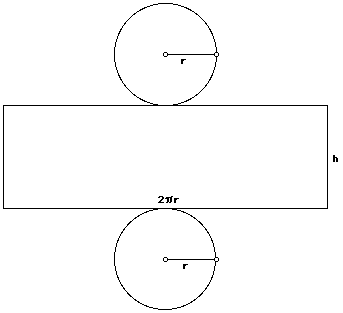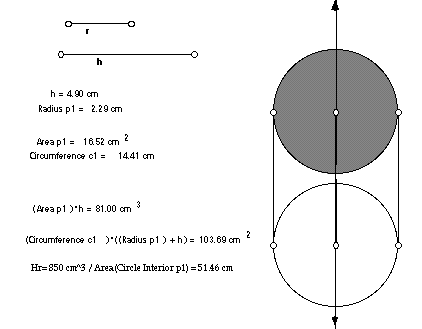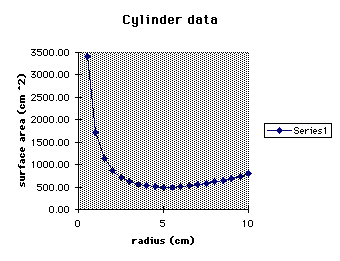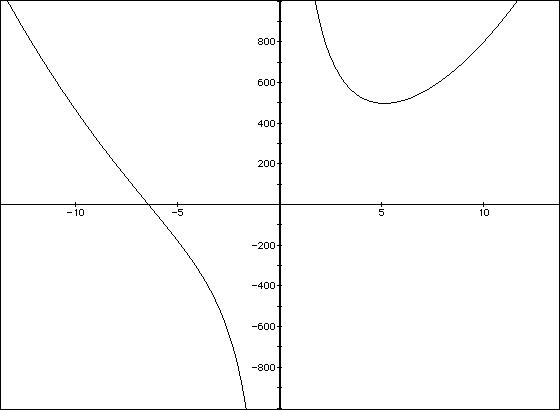

To investigate this problem, I went to the Geometer's Sketch Pad and
constructed a cylinder. I made a segment for radius and one for height.
One could drag either segment to change the radius and height respectively.
Then I calculated the area and circumference of one of the circles. From
these, I also calculated volume and surface area of the cylinder. Below
is the cylinder I constructed.

P1 is the label of the shaded circle interior, and C1 is the circle itself.
[(Area p1)*h] is the volume of the cylinder, and [(Circumference c1)*((Radius
p1)+h)] is the surface area of the cylinder. The equation for Hr above gives
the height that (with the shown radius r) would produce a volume of 850
ml.
Now let's take a look at a spread sheet chart of different radius values
and their corresponding heights (heights which will give a volume of 850
ml). Let's also see what the corresponding surface area is for different
radii.
The smallest surface area in the chart is 497.08, which occurs when the radius is 5 ( and height is 10.82) cm.Radius (cm) Height (cm) Surface Area 0.50 1082.25 3401.57 0.75 481.00 2270.20 1.00 270.56 1706.28 1.25 173.16 1369.82 1.50 120.25 1147.47 1.75 88.35 990.67 2.00 67.64 875.13 2.25 53.44 787.36 2.50 43.29 719.27 2.75 35.78 665.70 3.00 30.06 623.22 3.25 25.62 589.44 3.50 22.09 562.68 3.75 19.24 541.69 4.00 16.91 525.53 4.25 14.98 513.49 4.50 13.36 505.01 4.75 11.99 499.66 5.00 10.82 497.08 5.25 9.82 496.99 5.50 8.94 499.16 5.75 8.18 503.39 6.00 7.52 509.53 6.25 6.93 517.44 6.50 6.40 527.00 6.75 5.94 538.13 7.00 5.52 550.73 7.25 5.15 564.74 7.50 4.81 580.10 7.75 4.50 596.74 8.00 4.23 614.62 8.25 3.98 633.71 8.50 3.74 653.96 8.75 3.53 675.34 9.00 3.34 697.83 9.25 3.16 721.39 9.50 3.00 746.00 9.75 2.85 771.65 10.00 2.71 798.32

Below is a graph from Algebra Xpresser showing radius versus surface
area. Notice that the surface area is smallest when the radius is approximately
5. (And when r =5, height is approximately 10.)

One way to check our previous estimations is by using calculus. As stated
earlier, S=2[[pi]]r(h+r) and h=850/([[pi]] r^ 2). To get S in terms of one
variable, we can plug (850/[[pi]]r^2) in for h in the equation. We then
get S = 2[[pi]]r((850[[pi]]r^2)+r) = 1700/r + 2[[pi]]r^2. Taking the derivative
of S, we get S' = -1700r^2 + 4[[pi]]r. Setting this equal to zero and solving
for r, we get that r is approximately 5.13 cm. This gives us our desired
volume with a minimum surface area of 496.7 cm^2. (Height is 10.28 cm.)
Thus, to minimize surface area, the height of the can must be the same as
the diameter of the ends (h = 2r).
The relationship h = 2r will hold to minimize the surface area for any fixed
volume.
Below is a proof of this which used the arithmetic mean- geometric mean
inequality which states that for positive A1, A2, . . ., An,
(A1+ A2+. . .+An)/n > or = (A1*A2*. . .*An)(1/n) , with equality iff
A1=A2= . . . =An.
Proof: As stated earlier in the essay, V = [[pi]]r2h implies
h = V/([[pi]]r2),
and
S = 2[[pi]]r2 + 2[[pi]]rh
= 2[[pi]]r2 + 2[[pi]]r[V/([[pi]]r2)]
= 2[[pi]]r2 + 2V/r
= 2[[pi]]r2 + V/r + V/r .
By the arithmetic mean- geometric mean inequality, S > or = [(2[[pi]]r2)(V/r)(V/r)](1/3)
= (2[[pi]]V2)(1/3), which is a constant. Thus, S is larger than or equal
to this constant. Since we want to minimize S, we want it to equal the constant.
This happens iff 2[[pi]]r2 = V/r, which leads to h = 2r.